Pathological Diagnosis of Hepatocellular Cellular Adenoma according to the Clinical Context
- PMID: 23691330
- PMCID: PMC3652210
- DOI: 10.1155/2013/253261
Pathological Diagnosis of Hepatocellular Cellular Adenoma according to the Clinical Context
Abstract
In Europe and North America, hepatocellular adenomas (HCA) occur, classically, in middle-aged woman taking oral contraceptives. Twenty percent of women, however, are not exposed to oral contraceptives; HCA can more rarely occur in men, children, and women over 65 years. HCA have been observed in many pathological conditions such as glycogenosis, familial adenomatous polyposis, MODY3, after male hormone administration, and in vascular diseases. Obesity is frequent particularly in inflammatory HCA. The background liver is often normal, but steatosis is a frequent finding particularly in inflammatory HCA. The diagnosis of HCA is more difficult when the background liver is fibrotic, notably in vascular diseases. HCA can be solitary, or multiple or in great number (adenomatosis). When nodules are multiple, they are usually of the same subtype. HNF1 α -inactivated HCA occur almost exclusively in woman. The most important point of the classification is the identification of β -catenin mutated HCA, a strong argument to identify patients at risk of malignant transformation. Some HCA already present criteria indicating malignant transformation. When the whole nodule is a hepatocellular carcinoma, it is extremely difficult to prove that it is the consequence of a former HCA. It is occasionally difficult to identify HCA remodeled by necrosis or hemorrhage.
Figures
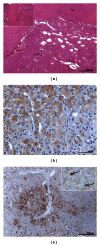
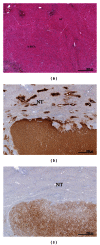
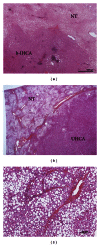

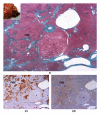


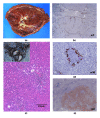
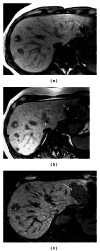
Similar articles
-
Hepatocellular adenomas: review of pathological and molecular features.Hum Pathol. 2021 Jun;112:128-137. doi: 10.1016/j.humpath.2020.11.016. Epub 2020 Dec 9. Hum Pathol. 2021. PMID: 33307077 Review.
-
Unexpected discovery of small HNF1α-inactivated hepatocellular adenoma in pathological specimens from patients resected for liver tumours.Liver Int. 2018 Jul;38(7):1273-1279. doi: 10.1111/liv.13667. Epub 2018 Jan 17. Liver Int. 2018. PMID: 29265678
-
Subtype classification of hepatocellular adenoma.Dig Surg. 2010;27(1):39-45. doi: 10.1159/000268406. Epub 2010 Apr 1. Dig Surg. 2010. PMID: 20357450
-
Changing trends in malignant transformation of hepatocellular adenoma.Gut. 2011 Jan;60(1):85-9. doi: 10.1136/gut.2010.222109. Gut. 2011. PMID: 21148580
-
Hepatocellular adenomatosis: what should the term stand for!Clin Res Hepatol Gastroenterol. 2014 Apr;38(2):132-6. doi: 10.1016/j.clinre.2013.08.004. Epub 2013 Oct 11. Clin Res Hepatol Gastroenterol. 2014. PMID: 24126236 Review.
Cited by
-
Hepatocellular adenoma management: advances but still a long way to go.Hepat Oncol. 2015 Apr;2(2):171-180. doi: 10.2217/hep.14.41. Epub 2015 May 15. Hepat Oncol. 2015. PMID: 30190996 Free PMC article. Review.
-
Is This Patient's Liver Mass Cancer?J Adv Pract Oncol. 2021 Jan-Feb;12(1):108-111. doi: 10.6004/jadpro.2021.12.1.9. Epub 2021 Jan 1. J Adv Pract Oncol. 2021. PMID: 33552666 Free PMC article.
-
Progression of non-alcoholic steatosis to steatohepatitis and fibrosis parallels cumulative accumulation of danger signals that promote inflammation and liver tumors in a high fat-cholesterol-sugar diet model in mice.J Transl Med. 2015 Jun 16;13:193. doi: 10.1186/s12967-015-0552-7. J Transl Med. 2015. PMID: 26077675 Free PMC article.
-
Phenotype or Genotype: Decision-Making Dilemmas in Hepatocellular Adenoma.Hepatology. 2019 Nov;70(5):1866-1868. doi: 10.1002/hep.30812. Epub 2019 Aug 12. Hepatology. 2019. PMID: 31206716 Free PMC article. No abstract available.
-
Sexual dimorphism in hepatitis B and C and hepatocellular carcinoma.Semin Immunopathol. 2019 Mar;41(2):203-211. doi: 10.1007/s00281-018-0727-4. Epub 2018 Nov 29. Semin Immunopathol. 2019. PMID: 30498927 Review.
References
-
- Hepatocellular Adenoma. eMedicine Gastroenterology, http://emedicine.medscape.com/article/170205-overview.
-
- Theruvath TP, Izar B, McGillicuddy J, Stewar E, Reuben A, Chavin KD. Hepatocellular adenoma in men: a rare cause for liver resection. The American Surgeon. 2011;77:373–376. - PubMed
-
- Monchal T, Barbier L, Hornez E, et al. Ruptured liver cell adenoma in man: great fortune in misfortune. Acta Chirurgica Belgica. 2010;110(5):555–557. - PubMed
-
- Goudard Y, Rouquie D, Bertocchi C, et al. Malignant transformation of hepatocellular adenoma in men. Gastroenterologie Clinique et Biologique. 2010;34(3):168–170. - PubMed
-
- Psatha EA, Semelka RC, Armao D, Woosley JT, Firat Z, Schneider G. Hepatocellular adenomas in men: MRI findings in four patients. Journal of Magnetic Resonance Imaging. 2005;22(2):258–264. - PubMed
LinkOut - more resources
Full Text Sources
Other Literature Sources

